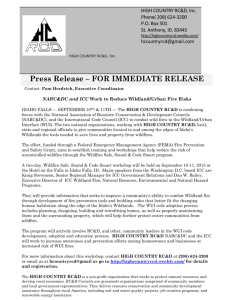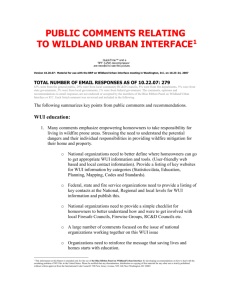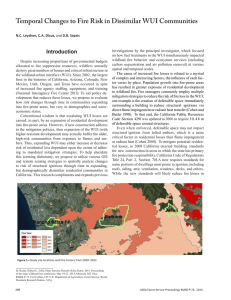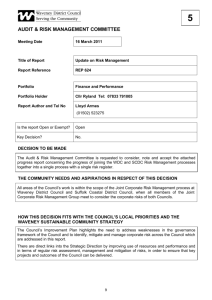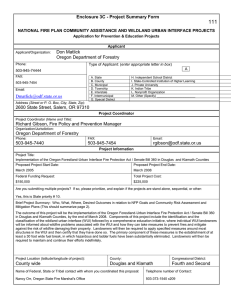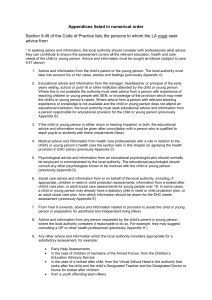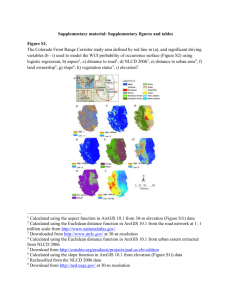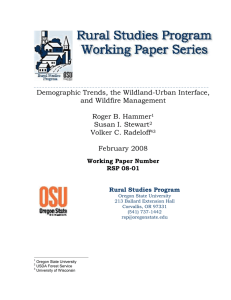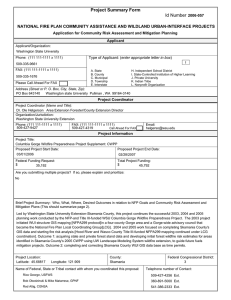CWPP Table Of Contents Template-DRAFT 4-1-14
advertisement
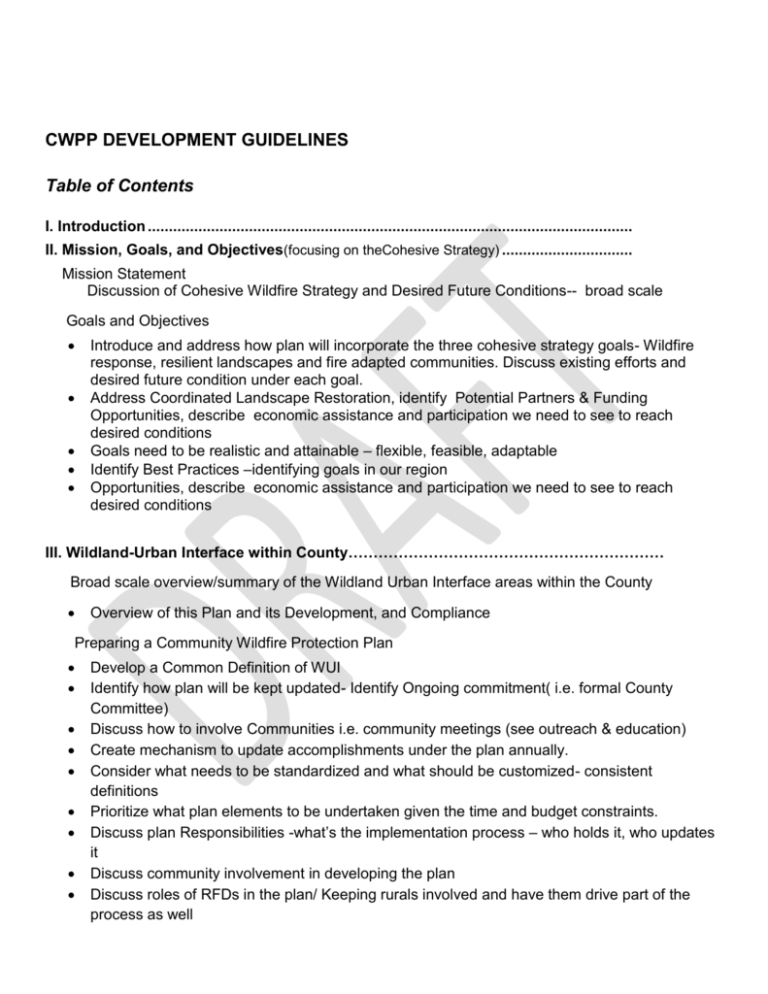
CWPP DEVELOPMENT GUIDELINES Table of Contents I. Introduction ................................................................................................................... II. Mission, Goals, and Objectives(focusing on theCohesive Strategy) ............................... Mission Statement Discussion of Cohesive Wildfire Strategy and Desired Future Conditions-- broad scale Goals and Objectives Introduce and address how plan will incorporate the three cohesive strategy goals- Wildfire response, resilient landscapes and fire adapted communities. Discuss existing efforts and desired future condition under each goal. Address Coordinated Landscape Restoration, identify Potential Partners & Funding Opportunities, describe economic assistance and participation we need to see to reach desired conditions Goals need to be realistic and attainable – flexible, feasible, adaptable Identify Best Practices –identifying goals in our region Opportunities, describe economic assistance and participation we need to see to reach desired conditions III. Wildland-Urban Interface within County……………………………………………………… Broad scale overview/summary of the Wildland Urban Interface areas within the County Overview of this Plan and its Development, and Compliance Preparing a Community Wildfire Protection Plan Develop a Common Definition of WUI Identify how plan will be kept updated- Identify Ongoing commitment( i.e. formal County Committee) Discuss how to involve Communities i.e. community meetings (see outreach & education) Create mechanism to update accomplishments under the plan annually. Consider what needs to be standardized and what should be customized- consistent definitions Prioritize what plan elements to be undertaken given the time and budget constraints. Discuss plan Responsibilities -what’s the implementation process – who holds it, who updates it Discuss community involvement in developing the plan Discuss roles of RFDs in the plan/ Keeping rurals involved and have them drive part of the process as well ...................................................................................................................................... IV. County Profile and Fire History ................................................................................. Profile ............................................................................................................................ Fire History on Private Land.......................................................................................... Fire History on Federal Land......................................................................................... V. Community Participation and Education................................................................... Outreach Inform residents in at risk of fire communities of their individual and collective responsibilities in preparing their homes and properties for the possibility of fire Conduct community meetings to drive development of the CWPP Consider conducting surveys or distribute pamphlets for landowners Conduct landowner meetings prior to publishing the plan to gather input. Consider field trips to share fuel reduction accomplishments. Fire Prevention and Education Consider conducting Fire-wise or other educational opportunities within communities VI. Wildfire Hazard Assessment ..................................................................................... Fire Occurrence/Risk of Ignition .................................................................................... Fuels / Vegetation Utilize common risk assessment analysis -West Wide Risk Assessment. Utilize West Wide Risk Assessment and other appropriate risk assessment models for identifying values at risk of fire Topographic Hazard ..................................................................................................... Total Wildfire Hazard .................................................................................................... Weather Hazard ............................................................................................................ Overall Fire Protection Capability Hazards (Structural Vulnerability) ............................ Values at-Risk ............................................................................................................... Using the Hazard Assessment to Score WUI Areas ..................................................... VII. Fuels Treatment, Maintenance, Biomass ................................................................ 1 Fuels Treatment and Forest Health ............................................................................ Fuels Maintenance Program ........................................................................................ Biomass Utilization ........................................................................................................ VIII. Emergency Management ......................................................................................... Infrastructure Protection Capabilities ............................................................................ Mitigation Action Plan for Emergency Services Address unprotected lands in the County and explore options to minimize Address Interoperability issues within the county and the BMIDC footprint. Address Training Requirements-Credentials .Identify Response Constraints for Agencies (Mutual Aid, Structural Protection), Acceptance of DPSST standards Address other values at risk of fire such as scattered farm /ranch communities and dwellings, isolated camp grounds, infrastructure improvements such as watersheds, communication sites, & critical habitats. Fire Siting/Zoning standards information. IX. WUI Specific Information WUI Mitigation Action Plans, Accomplishments and Maps Address smoke management issues with an interagency focus ( RFDs state, county,USFS ) Identify transportation needs- county wide -bridges, access roads Identify public works issues and ODOT, land use planning needs Establish Defendable WUI Boundaries-broader in scope – fuels/defensible space – what was best – ridge top/road Identify opportunities to increase fuels reduction effectiveness by coordinating “all lands”, collaborative treatment efforts across all ownerships (private, local, state, tribal, and federal). Identify opportunities for fuels treatment in the middle ground. Encourage projects that improve defensible wildfire buffers between wilderness/road less areas and private land to allow for management of fires when appropriate. Determine locations of Strategic Fuel Breaks which could provide protection to each WUI as part of the Eastside Strategy Project Identify non forest fuels that pose wildfire risk such as sagebrush, juniper, etc. Identify non-defendable areas Procure completed structure protection plans from previous fires. Identify Values at Risk- Priorities for protection Identify Mitigation Action Items(by WUI) Improving Wildfire Response Mitigation/Action Items -Goal -Discussion -Related polices and existing efforts Creating Fire Adapted Communities Mitigation/Action Items -Goal -Discussion -Related polices and existing efforts Restoring Resilient Landscapes Mitigation/Action Items -Goal -Discussion -Related polices and existing efforts Pre-fire Suppression Plan Look for opportunities to utilize RFDs in times of resource draw down, shoulder season events and pre planned dispatch. Identify wildlland/structure fire organizational structure to be implemented in each WUI Identify Significant Operational/Safety Issues - Discuss Interoperability issues within the WUI and consider establishing a Wildland fire communications plan. Develop “ALL AGENCY” fires suppression plans for communities at risk within the CWPP Desired future conditions-specific to each WUI Develop evacuation and transportation plans for communities at risk of fire Develop guidelines for response criteria or trigger points for invoking the conflagration act for communities at risk of fire. Long term planning of fire, transportation, developing alternative routes, easements, to identify secondary access opportunities/ Identify/create access maps, substandard roads/bridges. identify hydrants, bad roads,etc, possibly use RFDs to identify need for hydrants or fuels work Identify Structure Protection responsibilities Potential For Issues Water Sources Facilities Mutual Aid Agreements, Standardized use agreements X. Accomplishments Record of Accomplishments to Date within WUI Xi. Monitoring and Evaluation of the Plan ..................................................................... Schedule ....................................................................................................................... Monitoring ..................................................................................................................... Evaluation Create Flexibility to allows for additions & amendments Appendices Appendix A: Mutual Aid Agreements, Standardized use agreements Appendix B: Fire Statistics Appendix C: Natural Hazards Appendix D: Fire Regime / Condition Class Appendix E: Scoring Criteria Appendix F: Communities at Risk - Scoring Appendix G: Agency Fire Resources Summary Appendix H: List of Participants Appendix I: Glossary of Terms Appendix J: CWPP- Separate documents/plans Develop an Economics/Feasibility Review for creating Desired Fuel Conditions emphasis on non industrial Forestland Owners Economic Risk assessment Pre-fire identification of structure/location assessments/ triage Water source map/locations Fire camp locations
